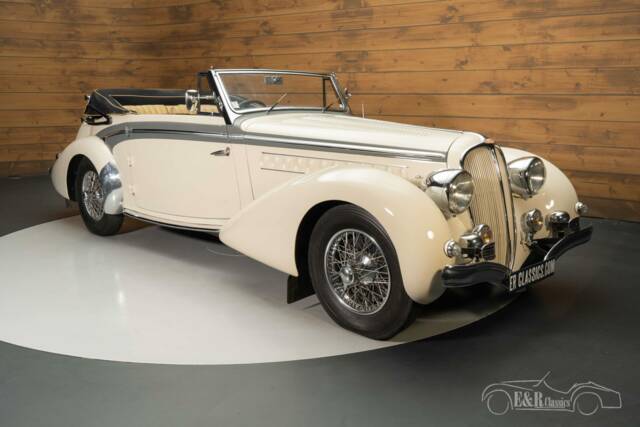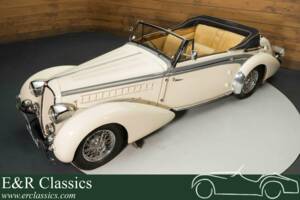Delahaye 148 classic cars for sale
The Delahaye 148 combines French coachbuilding tradition with technical refinement, standing as a rare representative in the classic pre-war luxury segment. As the only Delahaye model actively represented on the market, collectors find here a vehicle with substantial historical significance.
Search results

1939 | Delahaye 148 L Chapron "Mylord Grand Luxe"
Oldtimer Delahaye 148L by Chapron | Slechts 2 gebouwd | 1939
Delahaye 148 listing references from Classic Trader
Below you will find listings related to your search that are no longer available on Classic Trader. Use this information to gain insight into availability, value trends, and current pricing for a "Delahaye 148" to make a more informed purchasing decision.

1939 | Delahaye 148 L Chapron "Mylord Grand Luxe"
Delahaye 148L by Chapron | 1939 - For sale by auction. Estimate 249950 EUR

1939 | Delahaye 148 L Chapron "Mylord Grand Luxe"
Oldtimer Delahaye 148L by Chapron | Slechts 2 gebouwd | 1939
History of the Delahaye 148
The Delahaye 148 is a variant based on the Delahaye 135, which was one of the cornerstones of French luxury automotive engineering from the mid-1930s up to the 1950s. Developed as a blend of comfort and touring capability, the 148 model is distinguished by its larger chassis, catering to clients who favoured more spacious and prestigious vehicles. Like the 135, the 148 was predominantly bodied by renowned French coachbuilders, each adding their own stylistic signature, making each example unique.
Model Evolution and Series History
The Delahaye 148 evolved as a more luxurious and stately counterpart to the sporting 135 series. While the 135 was widely known for racing successes, the 148 targeted high-end clients seeking maximum comfort and presence. Its larger wheelbase allowed for elaborate four-door saloons and custom-bodied limousines, underscoring Delahaye’s adaptability to bespoke requirements. There was no direct predecessor in Delahaye’s line-up; the 148 instead extended the 135's platform. Successor models ceased after Delahaye’s absorption by Hotchkiss in the early 1950s.
Highlights of the Delahaye 148
A salient trait of the Delahaye 148 is its exclusivity: as a model, it was mainly reserved for custom orders and low-volume production. The combination of robust inline-six engines, ZF or Cotal gearboxes, and high-grade coachbuilt bodies made for a unique driving and ownership experience. The focus on handcrafted interiors, extensive use of chrome and fine materials, and the possibility to commission special bodies were all part of the 148’s appeal.
Technical Data
Special Editions and Collectible Models
Owing to its coachbuilt nature, most Delahaye 148s are effectively unique. Bodies commissioned from Figoni & Falaschi, Chapron, or Letourneur et Marchand are especially prized for their design intricacy and execution. Limousines, landaulettes, and coupés featuring special customer-ordered details—such as one-off sunroofs, advanced instruments, or rare upholstery options—are among the most notable examples.
Weak Spots and Common Issues
Survivors of the Delahaye 148 require attention to the chassis and body, particularly as many were bespoke coachbuilt cars prone to rust in sub-frames and sills. The complex linkages in the Cotal pre-selector gearbox demand specialist care, and replacement parts for the engine and braking system are challenging to source and often require custom fabrication. Authentic wiring and period switchgear may also present restoration challenges due to scarcity.
Engine and Performance, Transmission and Handling
While not as aggressively tuned as its sibling, the Delahaye 135, the 148 was engineered for smooth power delivery and cruising comfort. Its straight-six engine provided sufficient torque for relaxed, long-distance journeys, while the independent suspension contributed to an unusually refined ride by contemporary standards. The Cotal pre-selector gearbox, available on many cars, enabled seamless shifts, further distinguishing the 148 in the luxury class. Braking performance was on par for high-end French vehicles of the era, with hydraulic systems appearing on later examples.
Popular models include:
- 148 sedan bodied by Chapron—known for its understated elegance and rich interior woodwork.
- 148 coupé by Letourneur et Marchand—commended for sophisticated lines and balanced proportions. undefined
Interior, Comfort, Exterior and Design
The Delahaye 148 is instantly recognisable by its extended wheelbase and majestic proportions. Coachwork varied, but typically included sweeping fenders, elaborate chrome grilles, and deeply sculpted bonnets, all tailored to individual customer tastes. Interiors were appointed with generous use of walnut, high-quality leathers, and intricate gauges. Accessories of the period, such as integrated luggage racks, elaborate starting cranks, and bespoke dashboard clocks, were often fitted by request. Designer signatures, especially from Figoni & Falaschi or Chapron, can usually be spotted on sill plates or dashboard trim. Rarer factory options included sunroofs, advanced heaters, and auxiliary lighting—all highly desirable in a surviving example.
Other
With so few examples known to survive, preserving originality and documentation is crucial when dealing with the Delahaye 148. Many cars were ordered for ceremonial or diplomatic use, occasionally reflected in custom paintwork or armouring features, making provenance research particularly rewarding for historians. Enthusiasts often focus on matching numbers and coachbuilder authentication.
Summary
The Delahaye 148 stands as a testament to the engineering ambition and craftsmanship of pre-war France. It represents the epitome of luxury motoring from Delahaye’s heyday, combining distinctive technical features and true coachbuilt individuality. In today's market, it is uniquely positioned—being the sole actively traded Delahaye model—attracting connoisseurs interested in authenticity, technical heritage, and stylistic grandeur.
